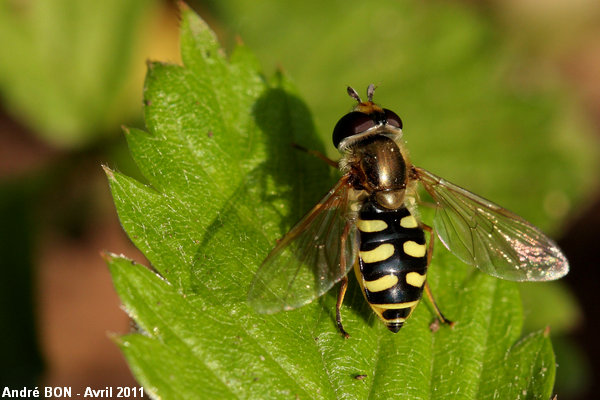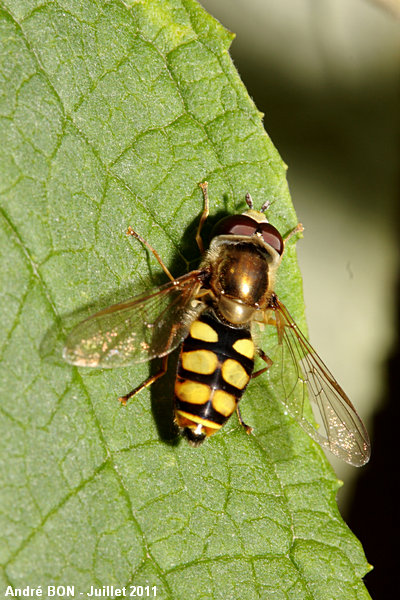

| Vagrant Hoverfly (Eupeodes corollae ((Fabricius, 1794))) |


|
|
Scientific name: Eupeodes corollae ((Fabricius, 1794)) Common name: Vagrant Hoverfly French name: Syrphe des corolles Order: Diptera Family: Syrphidae Wingspan : 10-12 mm. Biotope: Mooreland, parks, gardens and any place where you can find flowers, missing in water lands. Geographic area: Europe, North Africa, Asia. Introduced to South Africa. Observation period : March to November with a peak in July-August. |
This Hoverfly bears a resemblance to a wasp being then protected from predators. This is in fact a harmless insect. The abdomen shows yellow markings on a black background. The eyes are hairless. The lateral yellow marks are close but do not join on the female. Those of tergites 3 and 4 are coma-shaped and thin. These yellow marks join near the end of the male's abdomen. They are wider and more square-shaped on tergites 3 and 4. The Vagrant Hoverfly has a very quick lifecycle and there can be 6 to 7 generations in one year. Each female can lay 1000 eggs and each larva can eat 800 aphids. This is why this is a very useful insect already employed to protect some plantations. There is a possible confusion with Eupeodes luniger and with other species of the same genus. The yellow marks on tergites 3 and 4 show a small black border on the sides of the abdomen on Eupeodes luniger. This border is missing on Eupeodes corollae. Female Eupeodes luniger has a small Y-shaped black mark on the forehead. Hoverflies of the Scaeva genus have hairy eyes. |
| [To know more about the Vagrant Hoverfly] [Next picture] [Top] |

|
The separated eyes indicate one female. This matches the thin coma-shaped markings on the abdomen. The yellow marks do not seem to be bordered by black on the sides of the abdomen. That's why I have discarded Eupeodes luniger. |
| [To know more about the Vagrant Hoverfly] [Previous picture] [Top] |

|
The touching eyes indicate one male. The picture does not permit to evaluate if the yellow marks have a black border on the body side. However it seems that the yellow colour reaches the edge of the tergites. I have read that the yellow marks are always well separated on male Eupeodes luniger while they are often touching on male Eupeodes corollae. I do not know how reliable this information is. I think that we can classify this picture as Eupeodes corollae probable but not 100% sure. |